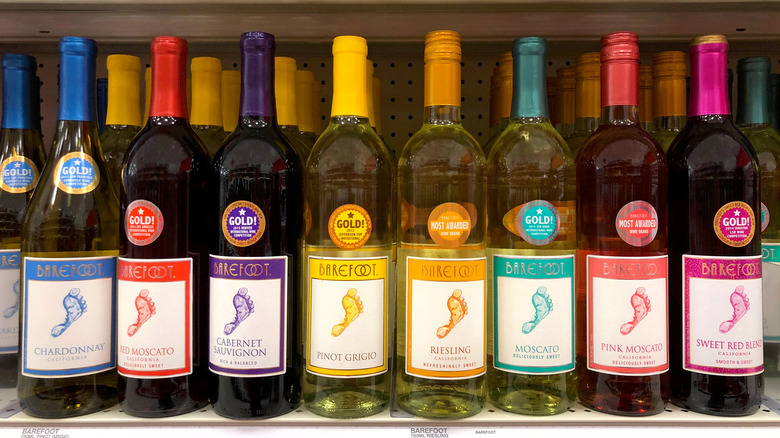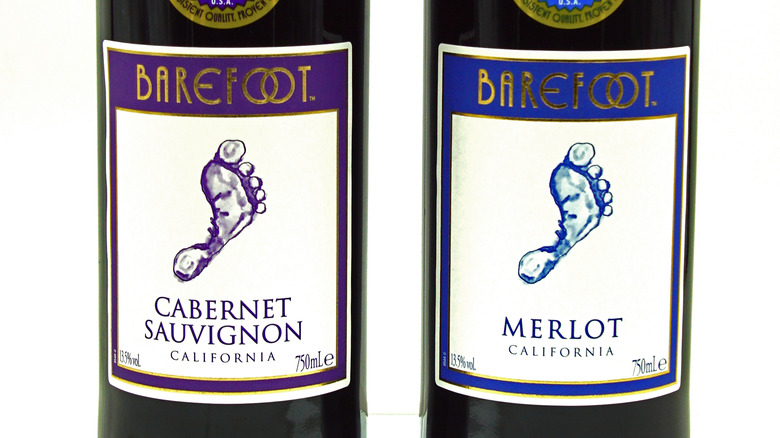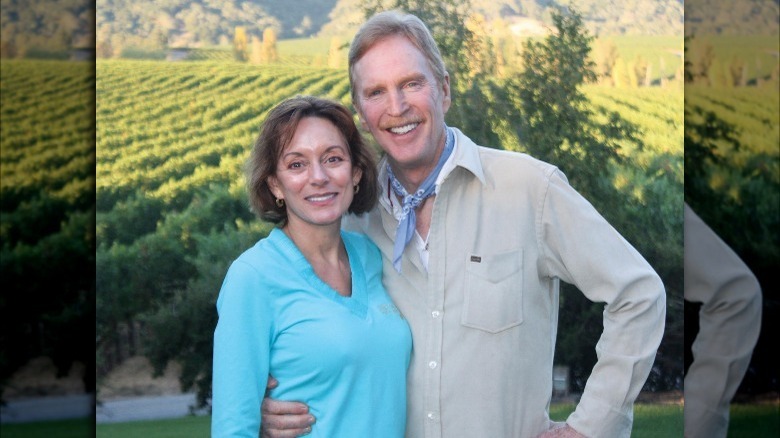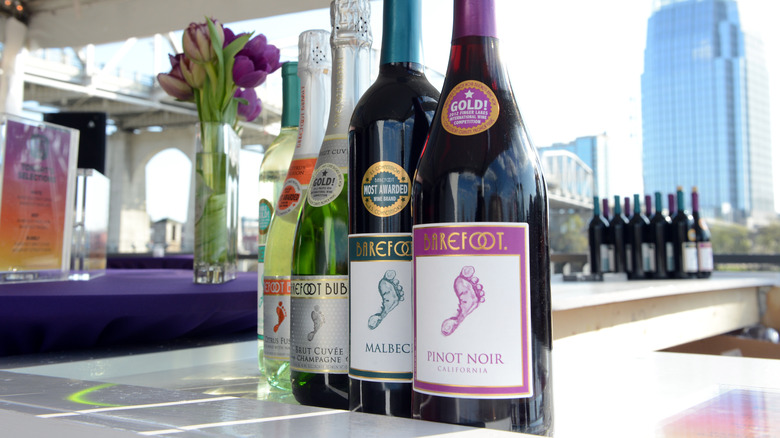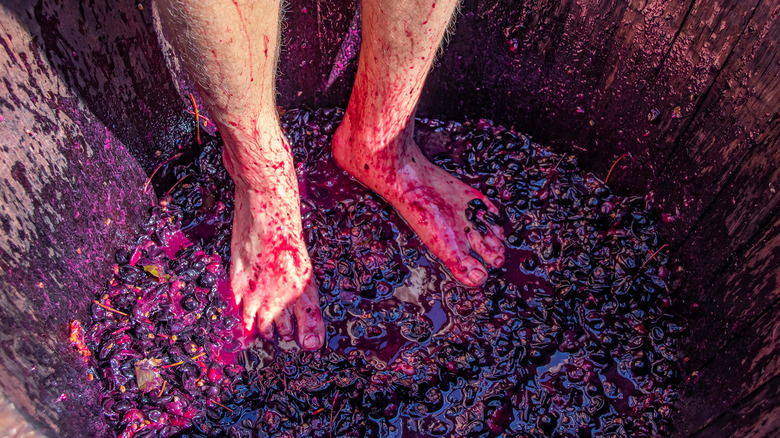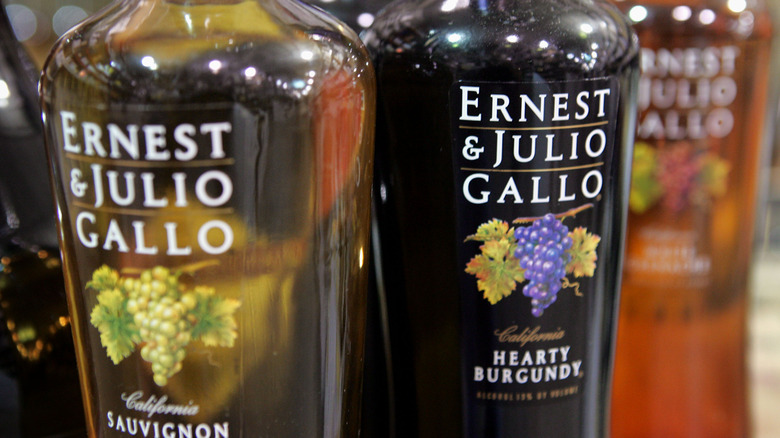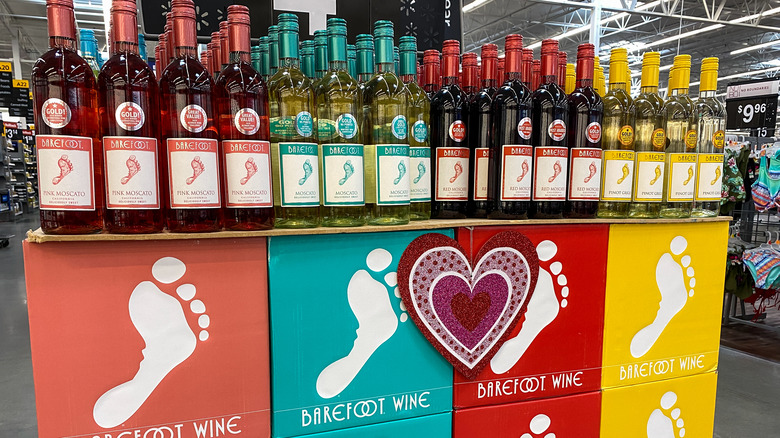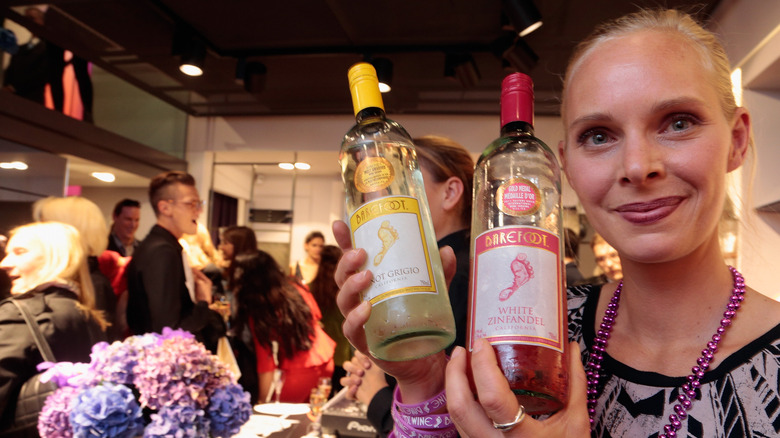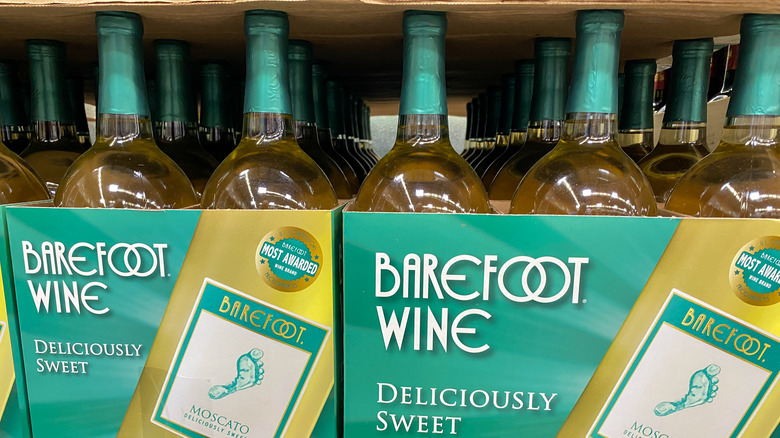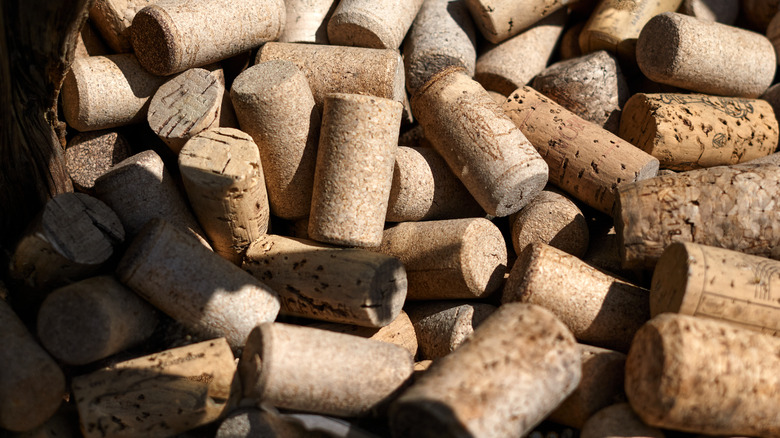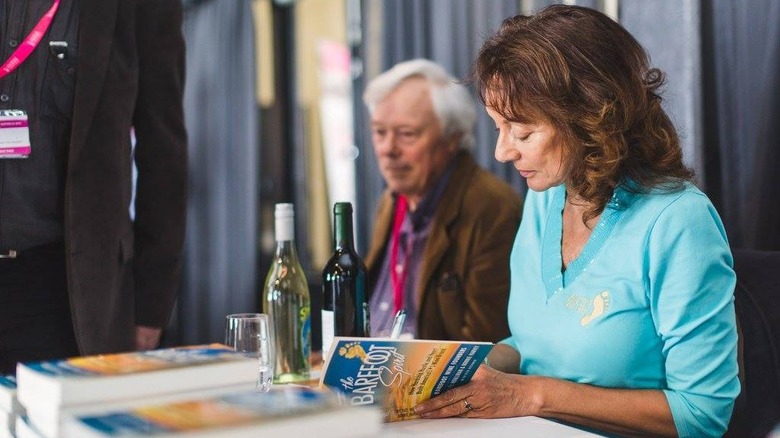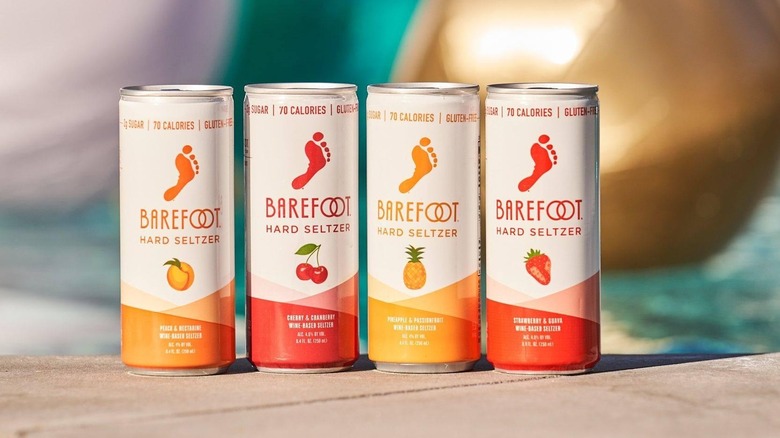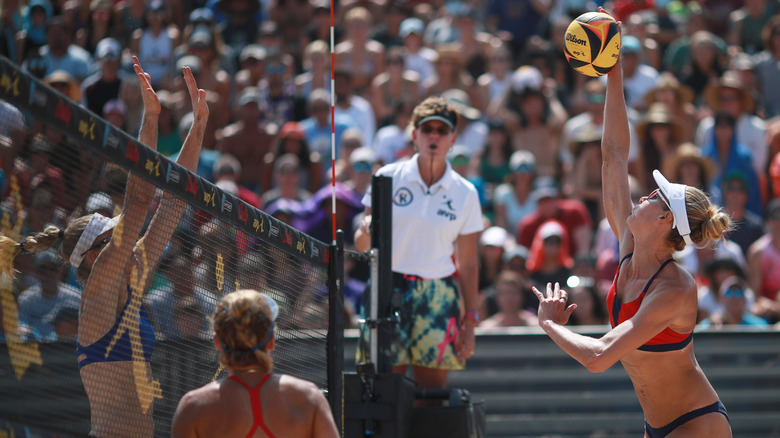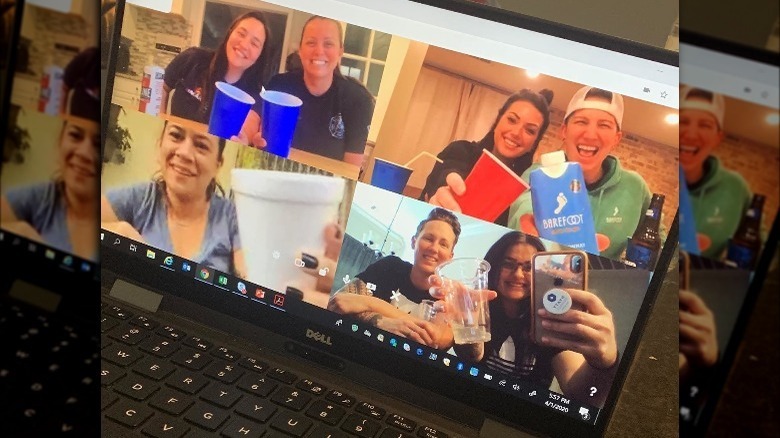The Untold Truth Of Barefoot Wine
If you've been anywhere that sells wine in the past 30 years, you've undoubtedly come across wine bottles affixed with an eye-catching footprint label. In fact, nowadays it probably seems like these bottles are everywhere you turn. It's not your eyes playing tricks on you — the brand known as Barefoot Wine really is that popular.
Barefoot's story begins more than half a century ago, but the brand as we know it today took foot in the 1980s. That's when two people who admittedly didn't know how to run a wine business took control of the company (via Forbes). These wine outsiders quickly realized that the way to success was to make an affordable and approachable wine. Today Barefoot is one of the most inexpensive wines on the shelf. It just so happens to be the best-selling vino in the country, according to Statista.
So, how did Barefoot go from operating out of a laundry room to being America's favorite wine? Here's the untold truth of Barefoot Wine.
The first Barefoot wine was created in a garage
Barefoot Wine's origins can be traced all the way back to 1965. That was the year a former newspaper reporter named Davis Bynum started making wine professionally. According to Wine Spectator, Bynum was working for the San Francisco Chronicle when his father purchased a vineyard in Napa Valley. The younger Bynum became a frequent visitor to wine country. On one fateful trip, he met famed winemaker Robert Mondavi and asked him how to make wine. Mondavi recommended speaking to one of his truck drivers, who made wine at home.
Bynum dabbled in the hobby of home winemaking for a few years before committing to it as his full-time job in 1965. That same year, the novice winemaker took some grapes out to his garage and concocted a burgundy wine. He named it Barefoot Bynum Burgundy. Just like that, the Barefoot Wine brand was born. Bynum continued making Barefoot Bynum wines when he opened his own California winery in 1973 (via Wine Enthusiast).
Barefoot Wine's owners had zero prior wine experience
Forbes reports that in 1986, entrepreneurs Michael Houlihan and Bonnie Harvey took control of Barefoot Wine. There was just one problem: The couple had precisely zero experience in the wine industry. What should have been a monumental detriment, however, turned about to be one of the keys to their success. Houlihan explained how in an interview with Forbes. "Because we lacked experience, we questioned everyone who touched our product, from clerks to buyers and from distributors to forklift drivers," he said. "We got real practical answers, not always available from the C-Suite. From buyers and clerks, we learned what wine package was needed in the market, rather than what we wanted to produce. From bottling line managers we learned what labels work and which ones don't and why. From a forklift operator, we got color-specific cartons to reduce miss-deliveries. The list goes on and on, and we built Barefoot on the backs of these challenges, so they were actually gifts in disguise."
Armed with practical wine knowledge, the couple turned their laundry room into a home office and went to work. They changed the company's name to Barefoot Cellars, created the now-iconic footprint label, and slowly but surely built up the Barefoot brand. "Because we really didn't know too much about the wine industry," Houlihan said, "we ended up revolutionizing it."
The Barefoot Wine brand grew by supporting nonprofits
When Barefoot Wine founders Michael Houlihan and Bonnie Harvey started the company, they lacked experience in the wine industry as well as one other critical asset: money. Houlihan told Forbes that they didn't have the capital for traditional advertising, so they needed to get creative. They came up with the idea of partnering with nonprofits. "Instead of money, we donated wine to their fundraisers, our time to their events, and our ability to take their cause to the marketplace," Houlihan said. "When we started to see our numbers climb in local territories, we continued to support non-profits in market after market to grow the brand nationally."
Barefoot named their method "Worthy Cause Marketing," and it proved to be an ingenious strategy. Not only did people enjoy the wine, but they also supported the company's mission. "It felt great to help causes we held dear like conservation, human rights, clean oceans, and beaches," Houlihan told Forbes. "The members of the nonprofits now had a social reason to buy and spread the word about our brand." To this day, Barefoot still supports many nonprofits, including those dedicated to the Black and LGBTQ+ communities.
Barefoot's name is a nod to the winemaking process
Bare feet are probably not what you want to be thinking about when you're sipping a delectable glass of wine. This much was made clear to the founders of Barefoot Wine when they were getting the brand off the ground. "The industry thought a wine with a foot on it would never sell," co-founder Michael Houlihan recalled to Forbes. Nonetheless, they stuck with the moniker. After all, it's the name winemaker Davis Bynum came up with when he made the first Barefoot wine in 1965.
But it wasn't just out of respect to Bynum that the owners kept the name. The Barefoot title is also a reference to the traditional winemaking process. Dating back to the Roman Empire, people would stomp on grapes with their bare feet to extract grape juice, which would be collected and turned into wine (via Mt. Vernon Winery).
Nowadays, foot-stomping has been replaced by machines, but the practice is still done occasionally, just for fun. This goes hand-in-hand with the Barefoot brand as well, which values its free-spiritedness. After all, its slogan is, "Get Barefoot and Have a Great Time!" (via Marketing the Rainbow).
Barefoot Wine is owned by the largest wine company in the United States
No one can argue that Barefoot isn't a big name in the wine world, but it's owned by an even bigger company. In 2005, the brand was bought by E. & J. Gallo, the largest wine company in the United States by volume, according to the San Francisco Business Times.
Gallo has a storied history. It was founded in Modesto, California, nearly a century ago by brothers Ernest and Julio Gallo. It has continued to grow its own wine operations over the last 90 years while simultaneously acquiring other wineries. All this has made Gallo one of the most prominent wine companies in the world. Just how big is Gallo? The Santa Rosa Press Democrat reported that at the time of the Barefoot acquisition the company owned more than a quarter of the entire U.S. wine market (via San Francisco Business Times). Wine-Searcher says that this has since gone up to more than 30 percent.
Barefoot has plenty of good company as part of the E. & J. Gallo portfolio, which consists of more than 100 different brands. Other notable lines under its control include Andre, Apothic, Boone's Farm, Carnivor, and Manischewitz.
Barefoot is the top-selling wine brand in the U.S.
To say Barefoot Wine had humble beginnings would be an understatement. When founders Michael Houlihan and Bonnie Harvey started the brand in 1986, they had very little money, zero wine experience, and were operating the company out of their laundry room (via Forbes). Little did they know what was in store for their burgeoning vino business.
In the 35 years since, Barefoot Wine hasn't just become a popular wine, it has become the most popular wine brand in the country. According to Statista, Barefoot sold $664 million worth of wine in the United States during a 12-month span ending in May 2021. That was far and away the most of any table wine brand in the country. The next closest was Sutter Home, which was more than $200 million behind.
It's not just the table wines that are selling well for Barefoot — people are also loving its bubbly. Statista reports that the brand's line of sparkling wine ranks fourth in sales in the category.
Barefoot is the best-selling wine in the world
Barefoot Wine isn't just the most popular wine brand in the United States; it's also got world domination on its mind. That's right — Barefoot has gone international. Barefoot Wine is sold in Canada, Mexico, Puerto Rico, Brazil, and other countries in the Americas. Across the pond, you can find it in the United Kingdom, Belgium, Denmark, Germany, the Netherlands, Poland, and Sweden. Barefoot can even be found as far away as Hong Kong and Korea.
In 2014, Barefoot entered the wine market in Australia. The country is one of the largest wine producers in the world (via Statista). As part of the new business venture, Barefoot began growing its own grapes in South Australia. The operation is managed by winemaker Jen Wall to ensure Barefoot Wine is just as good down under as it is in the states.
By widening its footprint, Barefoot has turned itself into the world's top-selling wine brand. According to a report by Drinks Trade, Barefoot sold 22.5 million cases of wine around the world in 2019, by far the most of any winemaker. Next up was Gallo, with 15 million cases sold.
Barefoot Wine is known for being very cheap
If there's one reason, above all else, why Barefoot has become the most popular wine brand in the country, it's the cost. As much as people may love the taste of the wine itself, the most alluring quality of a bottle of Barefoot wine is its price tag.
So exactly how cheap are we talking about here? The most expensive items on Barefoot's website are 3-liter boxes of wine (the equivalent of four bottles). These sell for under $20. All of Barefoot's 750 ml bottles of wine cost less than $6. According to BinWise, the average bottle of wine costs around $14, more than double what a bottle of Barefoot sells for.
It gets even better for Barefoot Wine lovers, and by better, we mean cheaper. The company sells 500 ml wine-to-go products for under $5 and cans of hard seltzers and spritzers for a measly $2.
Unlike many inexpensive wines, Barefoot still uses corks
According to The Wine Cellar Insider, corks have been used to seal wine bottles for hundreds of years. But if you've taken a look around your local wine store lately, you may have noticed that twist tops have become commonplace on bottles (via California Wine Club). There are a number of reasons wineries are making the change. Most notably, defective corks can ruin the wine itself, either by letting in too much oxygen or through cork taint, in which a chemical compound delivers an unwelcome aroma. According to Wine Enthusiast, cork taint affects about 10 percent of corked wine. Twist closures are also less expensive than corks, and, as any wine drinker will happily tell you, are significantly easier to open and close.
While some high-end winemakers have stayed loyal to cork, many others, especially budget brands, have made the switch. Barefoot, however, hasn't fully adopted twist closures, even though it is a decidedly affordable wine brand. Barefoot uses a screw cap on most of its white varietals and some other varieties. However, its chardonnay as well as most of its red wines, including pinot noir, cabernet sauvignon, and merlot, are all bottled with corks.
Barefoot Wine's founders wrote a book about the company
There's no denying Barefoot Wine has authored a remarkable success story, and it has led many people to ask: How did they do it? Former Barefoot Owners Michael Houlihan and Bonnie Harvey were asked this so many times they finally decided to peel back the curtain by authoring something else: a book (via The Barefoot Spirit).
The pair published "The Barefoot Spirit," which recounts the trials and tribulations of getting the brand off the ground, intertwined with some important business lessons they learned along the way. "There have been books written about wine and what it tastes like and where it's grown and about great winemakers," Houlihan told Wine Business Monthly. "There's never been a book written about how wine gets through the distribution system. In other words how wine gets to you — that's what's really interesting about this book."
The book became a New York Times bestseller and, according to the authors, is used in more than 60 entrepreneurship schools around the world. The Barefoot Spirit also opened up new career paths for the founders as keynote speakers and business consultants.
Barefoot Wine also makes hard seltzer
It's essentially a rule these days that every alcohol brand must release its own hard seltzer drink. Even though Barefoot has always been a wine producer, the company jumped on the bandwagon in early 2020. In January, the brand announced Barefoot Hard Seltzer would be rolled out nationwide the following month (via PR Newswire).
Trying to distinguish itself from the ever-growing hard seltzer crowd, Barefoot put a unique spin on its boozy drink. According to the company, its product is the first nationally distributed hard seltzer made with real wine. The 4% ABV drink has three main ingredients — Barefoot Wine, seltzer water, and natural flavor — and has just 70 calories and 2 grams of sugar. It comes in four varieties: Pineapple & Passion Fruit, Cherry & Cranberry, Peach & Nectarine, and Strawberry & Guava.
"At Barefoot, we are passionate about creating products that meet the various lifestyles and tastes of our diverse consumer base," Anna Bell, Vice President of Marketing at Barefoot, said in a statement. "With Barefoot Hard Seltzer, we wanted to create a delicious and light-bodied, wine-based hard seltzer that can be enjoyed at home, on the go, or with family and friends."
Barefoot sponsored professional beach volleyball
Mixing sports and wine is usually a recipe for disaster, so Barefoot Wine partnering with beach volleyball leagues might seem like an odd pairing. According to the wine company, however, it's a match made in heaven. Barefoot Wine is all about having fun. The company's slogan is "Get Barefoot and Have a Great Time!" (via Marketing the Rainbow). It even has a page on its website dedicated to having fun. What could be more fun and playful than a day at the beach? And if Barefoot is going to support a particular sport, why not one whose athletes compete without shoes?
In 2006, the brand partnered with the AVP Pro Beach Volleyball Tour. "We want to make wine fun — less intimidating," Stephanie Gallo, Barefoot's director of marketing, told Forbes at the time. Marketing manager Ann Polhemus Peltz expressed a similar sentiment a few years later when the brand teamed up with Championship Volleyball. "We are thrilled to team up with Championship Volleyball this summer, an organization as at home on the beach as we are," she said in a statement to PR Newswire.
Barefoot continued its support of beach volleyball in 2014 when it again partnered with the AVP. As part of the deal, Barefoot Bubbly would be used in all championship celebrations. "We're excited to partner with the AVP for its 2014 season, as we feel strongly that the Barefoot brand fits perfectly with the beach volleyball lifestyle," Barefoot brand manager Peaches Brady said.
Barefoot Wine went virtual during the pandemic
The COVID-19 pandemic made just about every company change the way it operates. It was no different for Barefoot, but the winemaker showcased an uncanny ability to adapt to the changing world. Unable to meet customers in person, Barefoot brought itself to its customers. One way it reached out was by broadcasting head winemaker Jennifer Wall near and far. "All of a sudden, we've had this opportunity to bring Jen to people, so she's been hosting virtual happy hours," Anna Bell, vice president of marketing at parent company E. & J. Gallo Winery, which owns Barefoot Wine, told Campaign US. "I feel like she's doing them daily. It's great because in the previous world we thought this would be physically impossible — you'd have to fly to a restaurant or grocery — but now it's Indiana today and New York tomorrow."
In March of 2020, just as lockdowns were going into place across the country, Barefoot partnered with "Jimmy Kimmel Live" for a special tasting episode. It also donated $300,000 to the nonprofit Children of Restaurant Employees (CORE). These tactics go hand-in-hand with Barefoot's community-centered ideals. "Barefoot has always been a mission-driven, purpose-driven brand," Bell said. "So, our strategy hasn't changed — which is really to bring people together to create those memorable moments and celebrate cheer, but also by supporting local communities."
